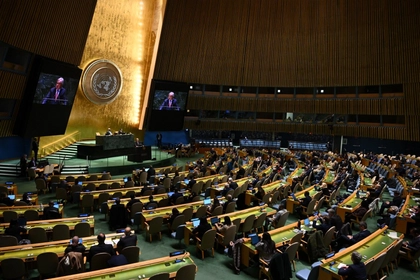Russia's first Moon mission in almost 50 years, the Luna-25 probe, has crashed on the Moon's surface after an unspecified incident during pre-landing manoeuvres, the Russian space agency Roscosmos said Sunday.
Here’s an overview of what happened interspersed with some of the best (most mocking) internet responses.
JOIN US ON TELEGRAM
Follow our coverage of the war on the @Kyivpost_official.
Why Luna-25 failed? pic.twitter.com/C9L44cPKWv
— Alex Bond (@AlexBondODUA) August 21, 2023
What happened?
Communication with Luna-25 was lost at 2:57 pm (1157 GMT) on Saturday, Roscosmos said. According to preliminary findings, the lander “has ceased to exist following a collision with the Moon's surface.”
“Measures taken on August 19 and 20 to locate the craft and make contact with it were unsuccessful,” the space agency added.
It said a ministerial investigation would be opened into the causes of the crash, without giving any indication of what technical problems might have occurred, AFP reports.
Putin's promised an immediate response to the moon's "provocative" downing of Russia’s Luna-25 spacecraft. He's now started a new book detailing "unfriendly" Planets. The moon was unavailable for comment. pic.twitter.com/f3YN6XAt5W
— Glasnost Gone (@GlasnostGone) August 20, 2023
The 800-kilogramme (1,760-pound) Luna-25 probe was to have made a soft landing on Monday on the Moon's south pole – which would have been a historic first.
Russia has not attempted to land on a celestial body since 1989, when the Soviet Union's Phobos 2 probe to explore the moons of Mars failed after an onboard computer malfunction.
Roscosmos chief Yuri Borisov had said the venture would be “risky.” telling President Vladimir Putin in June that the probability of it succeeding was “around 70 percent.”

US Urges Backing of ‘Simple’ UN Resolution as Trump Calls for Putin-Zelensky Talks
What was supposed to happen?
Luna-25 had been expected to stay on the Moon for a year, collecting soil samples and looking for water – an ingredient enthusiasts hope could be used to make rocket fuel for future launches and support potential colonies living there.
Moscow last landed a probe – Luna-24 – on the Moon in 1976, before shifting away from lunar exploration in favour of missions to Venus and building the Mir space station.
Tass reports Luna-25 successfully landed on the Moon in 10,000 separate pieces https://t.co/O6wc9IO390 pic.twitter.com/diXUgeWTE8
— @eliothiggins.bsky.social (@EliotHiggins) August 20, 2023
Landing Luna-25 successfully would have paved the way for further Russian missions to the Moon, at a time when India and China are launching their own probes and the United States returns to manned missions.
India's competing space probe, Chandrayaan-3, entered the Moon's orbit earlier in August, also with the goal of landing on the south pole.
Only Russia, the United States and China have previously achieved a controlled landing on the Moon.
According to preliminary calculations, the “Luna-25” station transitioned to an unplanned orbit and collided with the Moon, ceasing its existence, Roscosmos reported.
— Maria Drutska 🇺🇦 (@maria_drutska) August 20, 2023
Obviously, the Moon should have moved out of the way or just surrendered. So rude of it not to!
How big a disaster is it for Russia?
With Luna-25, Moscow had hoped to build on the legacy of its Soviet-era Luna programme, marking a return to independent Moon exploration in the face of financial troubles and corruption scandals at the programme and growing isolation from the West.
Valery Yegorov, a former researcher with Russia's space programme who now lives in exile, said the crash would severely affect Roscosmos's future missions, with the next one not planned until 2028 or “even later.
He suggested the probe's failure was linked to electronic problems, possibly resulting from Western sanctions on Moscow.
The Luna-25 launch was postponed several times in the last five years, Yegorov said, “because of sanctions imposed on Russia in response to seizing Crimea.”
The moon is to blame for Russia’s Luna-25 attacking it. Should’ve declared neutrality, ceded territory & stopping flirting with NATO.
— Darth Putin (@DarthPutinKGB) August 20, 2023
The crash comes almost a year and a half into Russia's full-scale invasion of Ukraine that has seen Moscow isolated, with punishing sanctions that have affected its space industry.
The failed mission comes as several companies and nations have entered a Moon race, and put a spotlight on the Russian space sector's troubles – from corruption to lack of innovation and partnerships.
Luna-25 was shot down by the moon pic.twitter.com/LTCqnN5YGi
— Ukraine Battle Map (@ukraine_map) August 21, 2023
Doubts had already emerged about Russia's long-running space cooperation with the West in the wake of its military campaign in Ukraine.
While Russia has said it intends to use the International Space Station until 2028, the European Space Agency (ESA) has dropped plans to co-operate with Moscow on Moon and Mars missions.
Live footage from Russia's failed Moon landing - with English translation. #Luna25 pic.twitter.com/67frEskgFq
— Glasnost Gone (@GlasnostGone) August 20, 2023
You can also highlight the text and press Ctrl + Enter














